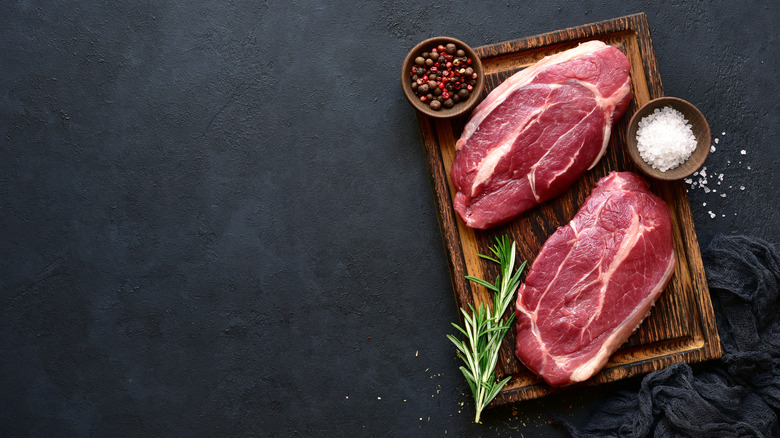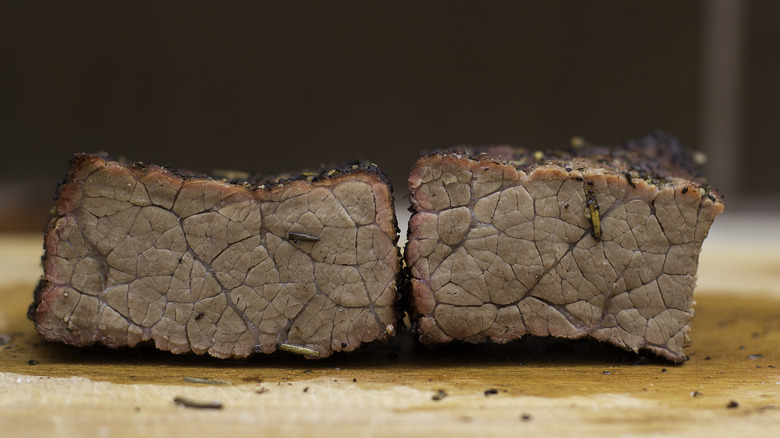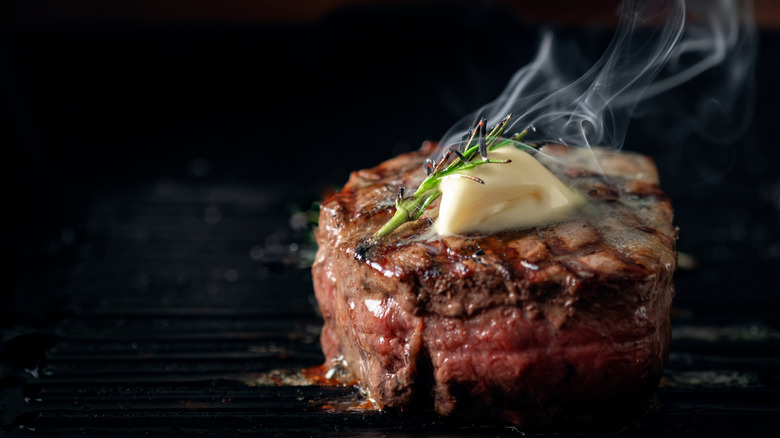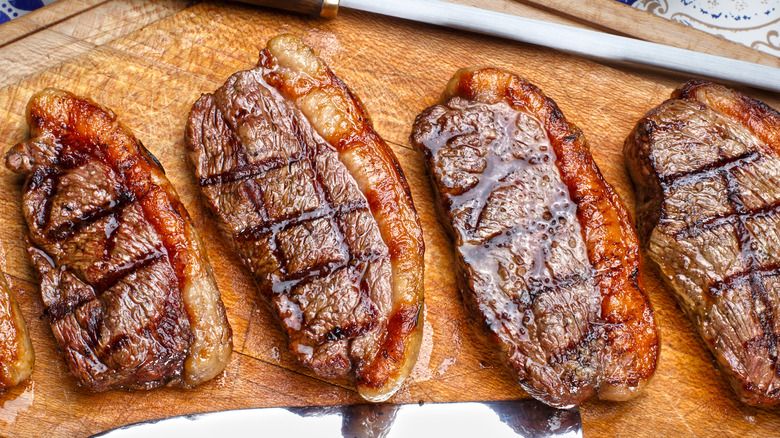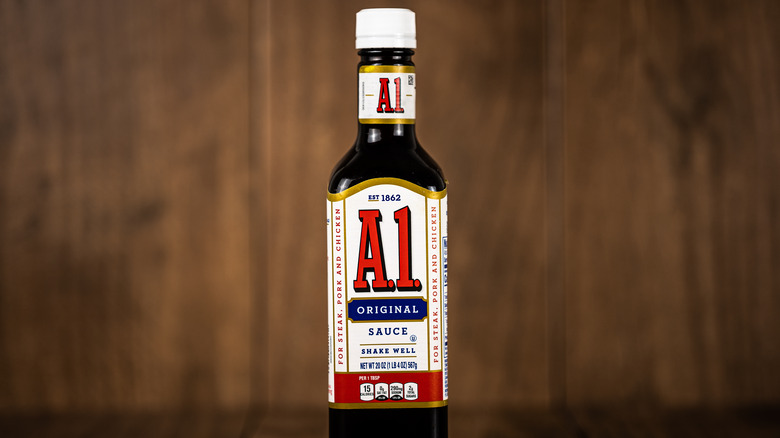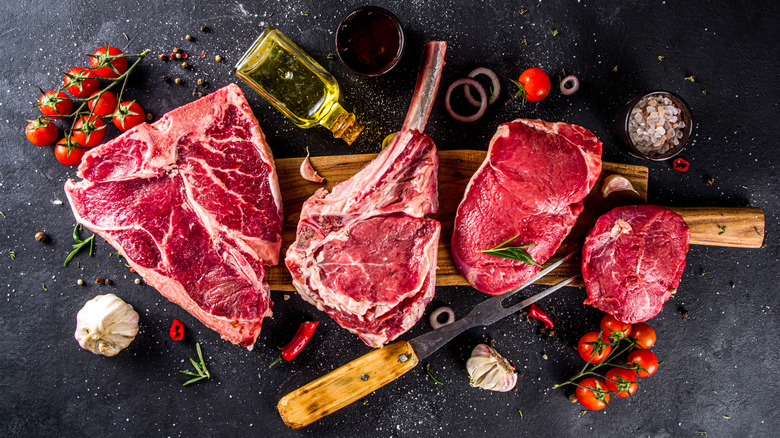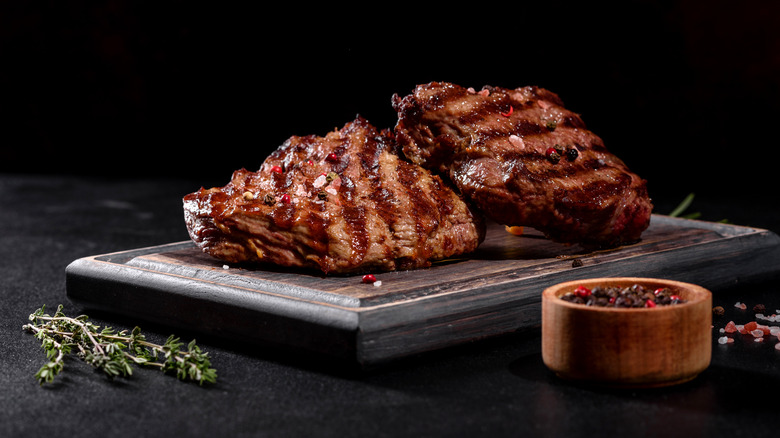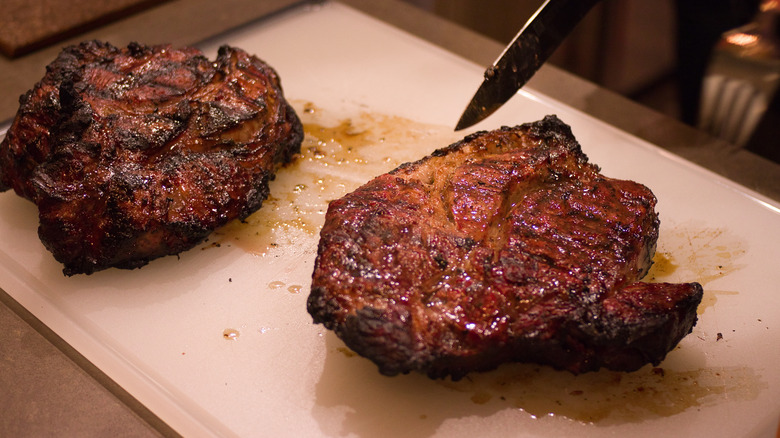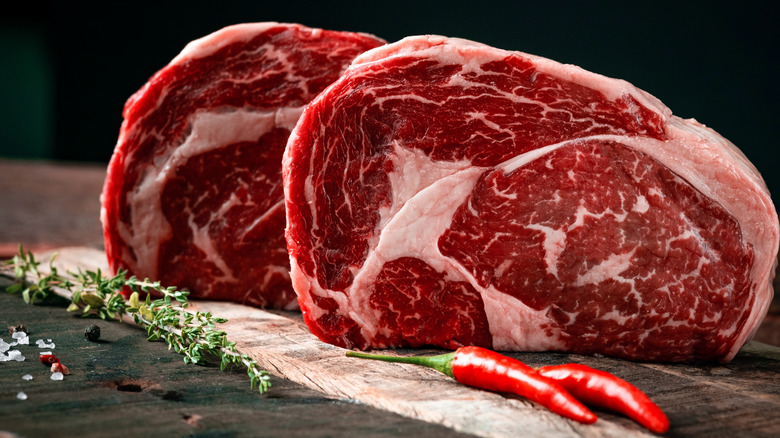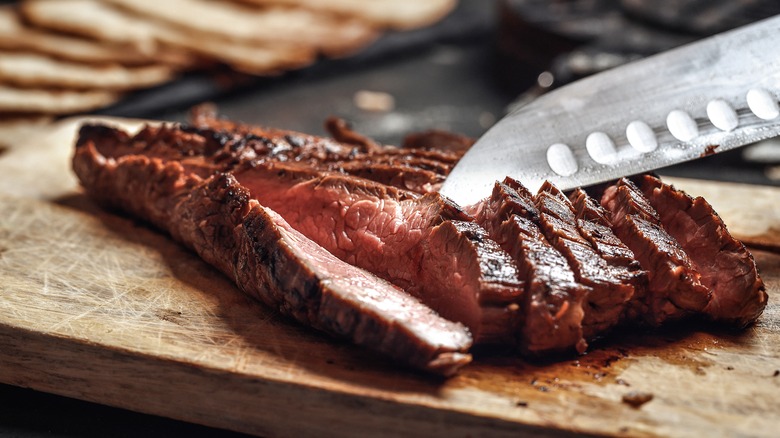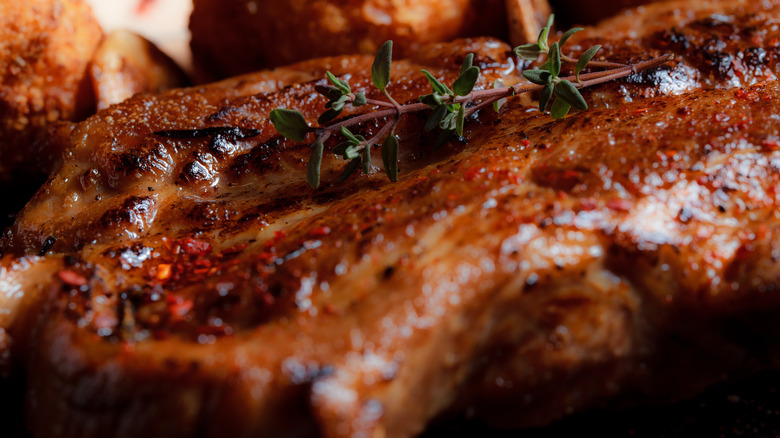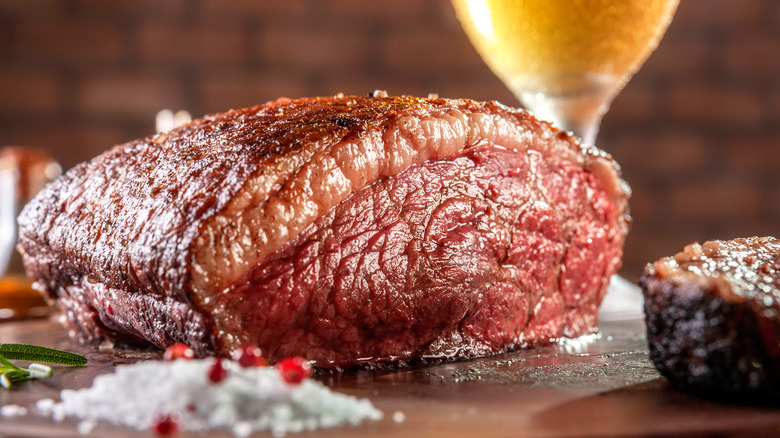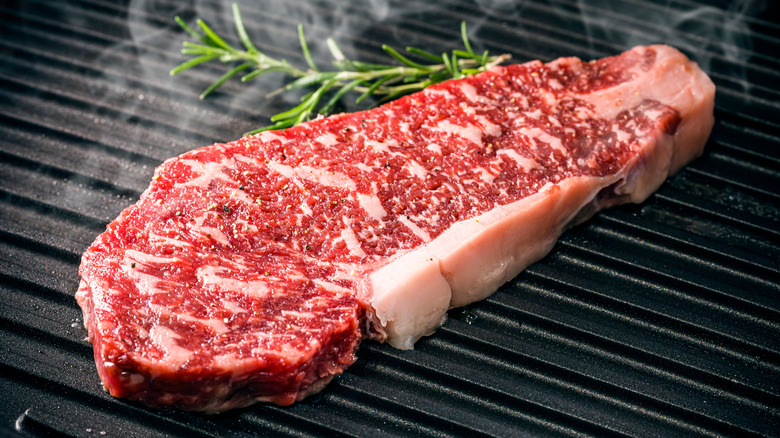12 Times You Should And Shouldn't Send Back Your Steak
When you order a steak, you expect a hot, delicious, juicy piece of meat. And sometimes, when it arrives, you get something ... not right. Isn't it supposed to have a bone? Why is there so much fat? Once you have a taste, you know something's amiss, but don't know how to describe it to the waiter. You could send it back, but it's too embarrassing to send it back to the kitchen without knowing why. So you eat the steak, even though it's chewy, fatty, or just plain. And if you like steaks that way, we'll reserve our judgment.
Do you want to know the difference between when you're eating a good steak and when you're basically setting your money on fire? We can give you some information that will help you the next time you eat out. Read our 12 tips on when you should and shouldn't send back a steak and you'll know exactly what to say if you have to confront the chef.
Send it back if it's overdone or underdone
When a server asks what temperature the steak should be, there's a right answer: Whatever temperature you ask it to be. Even if you ask for a well-done steak (the steak-lovers taboo), it should arrive the way you ordered it. If it comes out of the kitchen at a different temperature than the one you asked for, it's perfectly acceptable for you to send back the steak.
The key is to know what steak doneness you like and what that should look like after you cut into it. Certified Angus Beef notes that rare steak has a cool red center, medium-rare has a warm red center, medium has a warm pink center, medium-well has a slightly pink center, and well-done has little or no pink. When a steak is well-done, it becomes much chewier and tougher, and Delish even argues that it is a waste of money to order a well-done steak. However, it's up to you — if you like it that way, nobody should prevent you from enjoying your leathery steak!
Keep your steak if it's seasoned well
Giving a steak flavor means salting it well, letting it rest, and cooking it to the right temperature, according to Today. A steak's flavor shouldn't depend on a heavy sauce or something like ketchup — seasoning should highlight the natural taste of the meat. A perfect sear also brings out a steak's best flavor. When a chef allows the steak to rest, it will keep all of its tasty juices. When someone orders a steak, they're expecting a great meal, and the chef should do everything they can to make the steak as flavorful as possible without covering up the taste of the beef.
It's more difficult to adequately season a larger cut of meat. Steaks such as sirloin, tenderloin, roasts, and porterhouses are on the thicker side. When you order these, you're looking for them to be seasoned all the way through, with no bland bites. And frankly, if you don't like the flavor — no matter what you order — you should always send it back. The money you're spending means it's worth enjoying your meal.
Send it back if it's not marbled
The best steaks have beautiful, marbled fat running through them. These amazing steaks are called Prime, according to the USDA. Prime beef does not need to be marinated or served with a sauce to enrich the meat. It stands well on its own, and it's what you'd expect to find at a fancy steakhouse. There are also cuts of meat that have no marbling called USDA Select beef. Select beef can still taste very good if prepared correctly, but it's not so good for steak. That's because marbling helps ensure that steak will remain juicy, tender, and flavorful after it's cooked.
While intramuscular fat is desirable and makes meat juicy, what you don't want is big chunks of chewy fat surrounding the meat. The fat layer around the steak will not contribute to the steak's flavor or moisture levels and can be unpleasant to eat (via Steak Perfection).
Keep your steak if it's not smothered in sauce
A steak should be able to stand alone on its own. And while some steak dishes like steak au poivre are traditionally served with demi-glace or sauce, the sauce should be light and complement to the steak's flavor without overwhelming it. Ideally, a steak should be grilled with only salt, pepper, and maybe one more wild-card spice, according to Weber. Spices such as paprika or crushed chipotles enhance a steak's flavor, but too many spices at once can be distracting.
Having a steak covered in A.1. sauce or some kind of ketchup concoction does not do an excellent steak any favors. If you get a steak covered in one of these in a restaurant, it might be to cover up a badly-cooked steak. Check the steak under that mountain of sauce, don't let a restaurant ruin a great piece of meat by slathering sauce on top.
Send it back if it's not the right cut of meat
It's pretty common for people who couldn't pick sirloin out of a lineup to order sirloin. Don't let a chef take advantage of your lack of culinary prowess; make sure you learn what each cut of meat actually is. It'll also help you appreciate where your meat is coming from.
Animal Science breaks down the different cuts of steaks. Many are identified by their fat content, tenderness, and whether or not there is a bone included with the cut. Different cuts of beef taste better when cooked in different ways. A T-bone steak, for example, is recommended for broiling, grilling, pan broiling, or frying in a pan. It's typically well-marbled and comes with a bone (hence the name). It has a unique shape compared to a boneless ribeye. If your steak arrives and you know it's the wrong shape or size, that's a great reason to send it right back to the kitchen.
Keep your steak if it's thick and juicy
An ideal steak should be thick and juicy. According to Grill Baby Grill, while some cuts of steak are naturally thin, in general, thicker steaks taste better. Thicker cuts are easier to cook and bring to the temperature you want. If the chef undercooks it, a thick steak can be put back on the grill. Thick steaks are also harder to overcook. A thinner steak, with its short cooking time, is easy to overcook, particularly if you're shooting for rare or medium-rare.
Grill Baby Grill notes that there are three standard sizes (of thickness) for steaks: 1 inch, 1.5 inches, and 2 inches. Any thinner is going to be a difficult steak to pull off in the kitchen. With a steak that has one of these three thick measurements, you'll get a meaty, juicy, delicious steak — unless the chef has really done you wrong.
Send it back if there's too much gristle
Have you ever bitten into a steak that just takes forever to chew? You probably had some gristle in your meat. According to The Kitchn, there are two types of connective tissue in meat: collagen and elastin. Collagen breaks down under heat, so if a steak is cooked well, the collagen becomes edible and can actually give your steak a better texture. Elastin is another kind of tissue that connects the muscles together. Unlike collagen, elastin does not break down during the cooking process and should be cut away before the steak is cooked.
There's a lot of gristle in cuts from an animal's shoulders and legs. The chef can easily cut the gristle away, as it's easy to see the elastin in a piece of raw meat. If you get a plate with a lot of this kind of gristle, that means your meat wasn't properly trimmed before it was cooked. There's no excuse for this, so you should talk to your waiter.
Keep your steak if you're surprised by the size (in a good way)
Maybe you're craving steak and you decide to go for a relatively inexpensive hanger steak. If you end up being surprised with a thick tomahawk ribeye, keep your mouth shut and keep it at your table. While this seems to contradict our earlier advice about sending back the wrong cut of beef, if you accidentally received a bigger, more expensive steak, the mistake benefits you (as long as you don't have to pay extra, anyway).
Of course, this rule only applies if the steak you receive happens to be cooked to the temperature you like. If you win the lottery and get this kind of wrong order — say, a porterhouse instead of a flank steak — consider yourself lucky. In the end, if it's the wrong cut but you still enjoy the taste, that's all that matters, right?
Send it back if the meat is too tough
It can be so disappointing when you have a beautiful steak on your plate that ends up being chewy and tough when you take a bite. There are many reasons this might happen with steak. The most common reason for chewy and tough meat is the type of cut, notes Steak Revolution. Some cuts like ribeye and tenderloin are inherently tender, while others have dense muscle fiber. Those cuts need to be prepared just right to make them tender enough for pleasant eating. If they're not prepared well, you'll be chewing tem forever.
When we go out to eat, we hope the restaurant will be serving the best cuts of meat. However, if the cut comes from an animal that's too old, the cut will be much chewier and tougher to eat. The way a cow is raised also affects meat's texture. If the restaurant cares about what they're serving, they'll get meat that doesn't turn into shoe leather on the grill.
Keep your steak if the exterior is browned
It's tricky to achieve proper browning on acut of meat. The meat needs to be cooked on a very hot and dry pan. It can be difficult to do this while also ensuring that the meat doesn't burn. The chef also needs to make sure that the meat's flesh isn't overcooked. According to Modernist Cuisine, meat browns during cooking because of the Maillard reaction. The meat browns when amino acids and sugars rearrange themselves in rings that reflect light in a particular way. When this happens, you'll see a crusty brown color on the meat.
More importantly, the Maillard reaction ensures that the meat will have a delicious flavor and aroma. A steak that is perfectly crusty and brown on the outside is an amazing thing. So if your steak has gone through the Maillard reaction and looks wonderfully brown, that's a sign that you should keep it and eat it.
Send it back if it's cold
You should send back any dish if it's cold, but steak is specifically at risk since it has to rest for a certain amount of time. The chef might have forgotten all about it. And if the steak doesn't rest after being thrown on the grill, a lot of juices (ones that give it good flavor) will escape once you cut into it. According to WebstaurantStore, the minimum time for resting the meat is 5-7 before cutting into it. A thick cut of meat should rest for at least 10-20 minutes. For each inch of thickness, you have to add 5 minutes for resting.
The goal is to ensure the center of the steak is cool enough so the juices can be reabsorbed into the meat. During the cooking process, these juices become constricted. When you cut into a steak that hasn't rested for enough time, these juices will pool beneath your steak. However, if you let meat rest for too long, it will go from juicy and beautiful to cold and unappetizing. If that happens, it's your right to send it back and have it warmed up.
Keep your steak if it's properly trimmed
Knowing the difference between marbling and fat is crucial for knowing how good the cut of meat is on your plate. The Spruce Eats notes that even the most perfect steak has a layer of fat on the outside that needs to be trimmed off. The fat does contribute to the flavor of the steak, so there should still be a very thin layer left — don't think that any fat on the outside of the steak means it's cooked wrong.
While fat helps the flavor, a big layer will cause flare-ups while cooking and can squeeze out the juices. This will make the steak tougher and more difficult to eat. After the steak is trimmed, it will shrink to an ideal size. The strip of fat should be ⅛ to ¼ inch thick before it's cooked. The fat should also be sliced every inch or so. This ensures the fat won't curl and put pressure on the meat, which causes juice to escape while it's being cooked.
